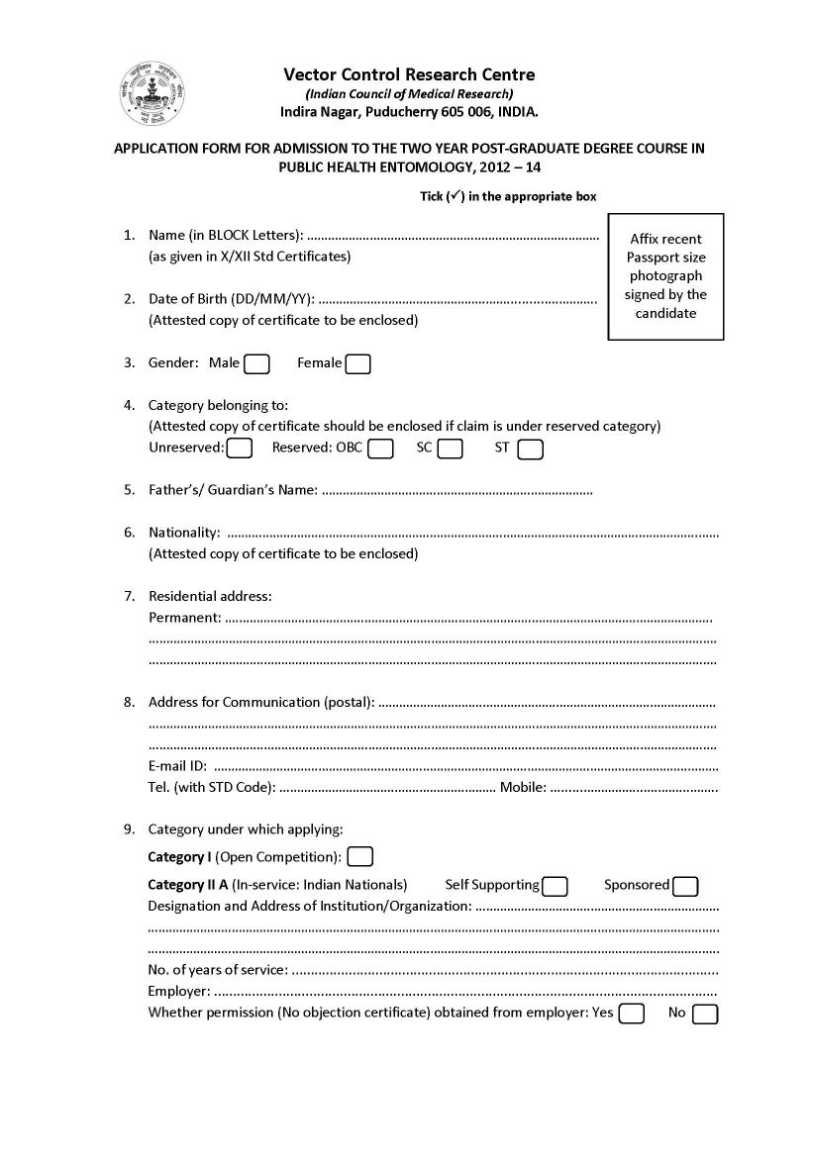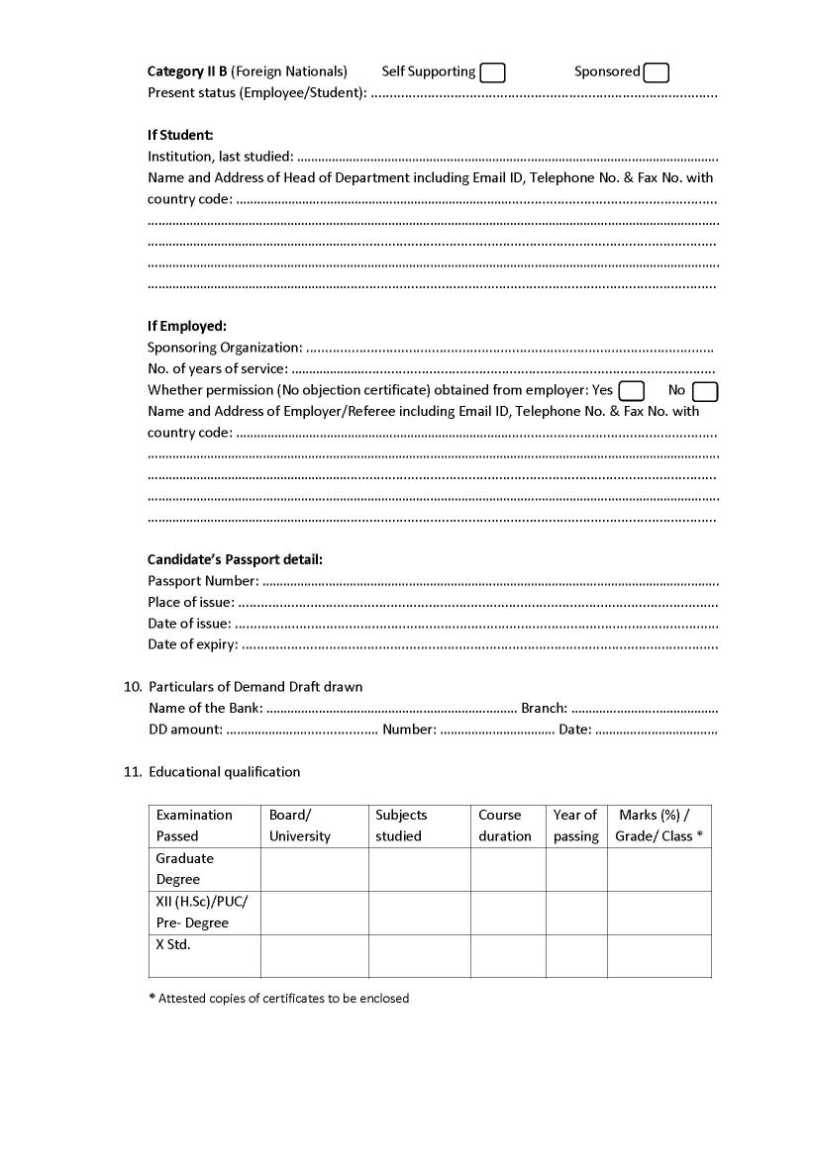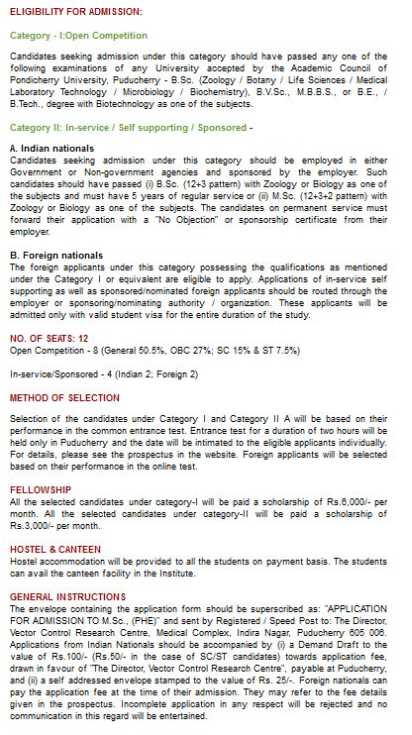|
#1
| |||
| |||
|
Guys, can you provide me the Vector Control Research Centre MSc PHE application form???
|
|
#2
| |||
| |||
|
Vector Control Research Centre offers two year Post-Graduate Degree Course in Public Health Entomology. The course is affiliated to the Pondicherry University, Puducherry. Following are the details of this program: Eligibility: The applicant should have completed B.Sc., in the discipline of Zoology / Botany / Life Sciences / Medical Laboratory Technology / Microbiology / Biochemistry, or B.V.Sc., or M.B.B.S., or B.E., / B.Tech., degree with Biotechnology as one of the subjects from any recognized university of India. As you required for the Vector Control Research Centre MSc PHE application form, here I am providing you which contains the same. you can use it in your purpose.    for additional information please contact to the address given below: Address Vector Control Research Centre Medical Complex, Indira Nagar 605006,, VCRC Rd, Gorimedu, Priyadarshini Nagar, Puducherry, 605006 0413 227 2396
__________________ Answered By StudyChaCha Member |
|
#3
| |||
| |||
|
Applications for admission to 2 years Post-Graduate Degree Course in Public Health Entomology is over now. So the application form too is not available now. The course is affiliated to the Pondicherry University, Puducherry. Eligibility for Admission: Category - I: Open Competition Candidates seeking admission under this category must have passed any one of the following exams of any University which is accepted by the Academic Council of Pondicherry University, Puducherry - B.Sc. (Zoology / Botany / Life Sciences / Medical Laboratory Technology / Microbiology / Biochemistry), B.V.Sc., M.B.B.S., or B.E., / B.Tech, degree with Biotechnology as one of the subjects. Category II: In-service / Self supporting / Sponsored - A. Indian nationals Candidates seeking admission under this category need to be employed in either Government or Non-government agencies and sponsored by the employer. Such candidates must have passed (i) B.Sc. (12+3 pattern) with Zoology or Biology as one of the subjects and must have 5 years of regular service or (ii) M.Sc. (12+3+2 pattern) with Zoology or Biology as one of the subjects. The candidates on permanent service must forward the application with a "No Objection" or sponsorship certificate from their employer. B. Foreign nationals The foreign applicants under this category possessing the qualifications as mentioned under the Category I or equivalent can apply. Applications of in-service self supporting and sponsored/nominated foreign applicants need to be routed through the employer or sponsoring/nominating authority / organization. These applicants are admitted only with valid student visa for the entire duration of the study. Details M.Sc. Public Health Entomology  Syllabus SYLLABUS MPHE101: Arthropods of Public Health Importance Unit I Introduction to arthropods of public health importance Arthropods, diseases and epidemiological triad - vectors - pests - transmission - cyclic and secular trend of diseases. Unit II Arthropods as vectors of human diseases Modes of disease transmission: vertical and horizontal transmission - biological, mechanical and contact - transmission cycle - interseasonal maintenance. Unit III Anthroponotic diseases Malaria, filariasis, visceral leishmaniasis, onchocerciasis, trypanosomiasis, Chagas disease, scrub typhus, tick typhus - Disease vectors - distribution and transmission - socio-economic impact on human population. Unit IV Zoonotic diseases Cutaneous leishmaniasis, schistosomiasis, plague, Kyasanur Forest Disease (KFD), leptospirosis, dracunculiasis - Disease vectors - distribution and transmission - socio-economic impact on human population. Unit V Arthropods of Public health nuisance Houseflies, cockroaches, lice, bugs, scorpions, centipede, millipede, wasps, bees, beetles, spiders, ants - distribution and impact on human health - toxins, venoms - allergy, asthma. Unit VI Natural enemies of arthropods Competitors - pathogens - parasites - parasitoids - predators - distribution and their role M.Sc., Public Health Entomology MPHE102: Morphology, Taxonomy and Bio-diversity of Vectors Unit I Morphology of medically important insects and other arthropods Head: antenna - mouth parts, Thorax: wings - wing venation - legs - general structure, Abdomen: Appendages - cerci - external genitalia. Unit II Taxonomic concepts and Classification of Arthropoda Type concept - Population concept - Levels of Taxonomy: alpha - beta - gamma taxonomy. Taxonomic hierarchy: Species - Genus - Family - Order - Class - Phylum. Species concept: species - infraspecific categories - Sibling species - subspecies - variants within populations. Characteristics of different Classes of Arthropoda. Classification of Insecta. Characteristics of Orders: Diptera - Siphonaptera - Anoplura - Hemiptera - Dictyoptera. Unit III Classification of Diptera Characteristics of Families Culicidae - Phlebotomidae - Muscidae - Tabanidae - Calliphoridae. Characteristics of mosquitoes - Anopheles - Culex - Aedes - Mansonia. Characteristics of sand flies: Phlebotomus - Sergentomyia. Characteristics of flies: Musca - Calliphora. Unit IV Classification of Siphonaptera and Anoplura Characteristics of Family Pulicidae. Characteristics of fleas: Xenopsylla - Pulex - Ctenocephalides. Characteristics of Pediculus - Pthirus. Unit V Classification of Acarina Characteristics of families Ixodidae - Argasidae - Trombiculidae - Sarcoptidae, Characteristics of Ticks: Boophilus - Ripichephalus – Haemaphysalis – Ornithodoros, Characteristics of mites: Leptotrombidium - Sarcoptes. Unit VI Collection and preservation techniques Mosquitoes - sandflies - fleas - lices - ticks - flies. Unit VII Biodiversity Concepts and characteristics of biodiversity - Biodiversity hotspots - Biosphere - Species documentation - Diversity indices - Invasive species. Relationship between anthropogenic stressors - vector biodiversity. Unit VIII Molecular taxonomy Theory and practice of molecular taxonomy- Molecular techniques in mosquito taxonomy: RFLP - RAPD - Microsatellites - SNPs - Microarrays - DNA bar coding. M.Sc., Public Health Entomology MPHE103: Biology and Ecology of Vectors of Public Health Importance Unit I Mosquitoes Biology: life cycle - mating, host seeking, feeding, resting, oviposition behavior - longevity, gonotrophic cycle, fecundity, survival. Salient features and distribution of important vector species of Anopheles (An. stephensi, An. culicifacies, An. fluviatilis), Aedes (Ae. aegypti, Ae. albopictus), Culex (Cx. quinquefasciatus, Cx. tritaeniorhynchus), Mansonia (Ma. annulifera, Ma. uniformis). Unit II Sand flies Biology: life cycle - mating, host seeking, feeding, resting, oviposition behavior- longevity, gonotrophic cycle, fecundity, survival. Salient features and distribution of important vector species of Phlebotomus, Sergentomyia. Unit III Other dipterans of public health importance Biology: life cycle and distribution of Black flies, Horse flies, Tsetse flies, House flies, Myiasis causing flies, Biting midges. Unit IV Fleas Biology: life cycle and distribution of Fleas - Salient features of important species of Xenopsylla, Ctenocephalides, Pulex, Tunga. Unit V Bugs and Lice Biology: life cycle and distribution of Bed bugs, Triatomine bugs, Head louse, Body louse. Unit VI Ticks and Mites Biology of Ixodid and Argasid ticks - Salient features of important species of Haemaphysalis, Ixodes, Dermacentor, Rhipicephalus, Amblyomma. Biology of mites - Salient features of important species of Sarcoptes, Leptotrombidium, Dermatophagoides. Unit VII Vector Ecology Introduction to ecology and ecosystem - Habits and habitats - Species diversity - Food chain, food web, ecological niche, prey predator relationships - Interaction with biotic and abiotic factors - Dispersal and migration. M.Sc., Public Health Entomology Unit VIII Population Ecology Population structure and methods of sampling - Estimation of relative and absolute density. Population dynamics - Natality, mortality, survivorship, age distribution - Life table studies. M.Sc., Public Health Entomology MPHE104: Physiology and Biochemistry of Vectors of Public Health Importance Unit I Integumentary system Formation of insect cuticle - Biochemical composition of various layers - Physiology of moulting - Secretion and composition of moulting fluid - Moulting associated enzymes and hormones. Unit II Digestion and nutrition Structural regions of the gut with reference to gut barriers in vectors - Digestive enzymes - Peritrophic membrane formation and function in haematophagous insects - Biting periodicity, blood digestion and abdominal conditions in haematophagous insects - Nutritional requirements and metabolic pathways in haematophagous insects. Unit III Respiratory system Structural regions, adaptations, and functional properties with special reference to aquatic forms of mosquitoes - Cyclic or discontinuous respiration - Respiratory metabolism and cytochrome oxidase system. Unit IV Circulatory system and haemolymph Circulatory system structure - Mechanism and neuronal/hormonal control of circulation - Haemolymph constituents and functions - Haemocytes, haemopoietic organelles and immune molecules - Phenoloxidase system, melanization and encapsulation. Unit V Excretion and osmoregulation Structural design of organs of excretion with special reference to aquatic stages of mosquitoes - Excretion in haematophagous insects - Osmoregulation in terrestrial and aquatic insects - Physiology of osmoregulation in aquatic stages of mosquitoes. Unit VI Nervous system and sense organs Regions of nervous system - Physiology and co-ordination of nervous system components, sense organs - Circadian rhythm in haematophagous insects - Sensory physiology of host -seeking behaviour in mosquitoes- Pheromones and control of insect behaviour. Unit VIII Reproduction and development Vitellogenesis and spermatogenesis - Fertilization, zygote formation and embryogenesis - Metamorphosis - Endocrine control of development and maturation - Autogeny, gonotrophic cycle and physiological age determination in mosquitoes. Contact Detail: Vector Control Research Centre VCRC Road, Puducherry Map:
__________________ Answered By StudyChaCha Member |